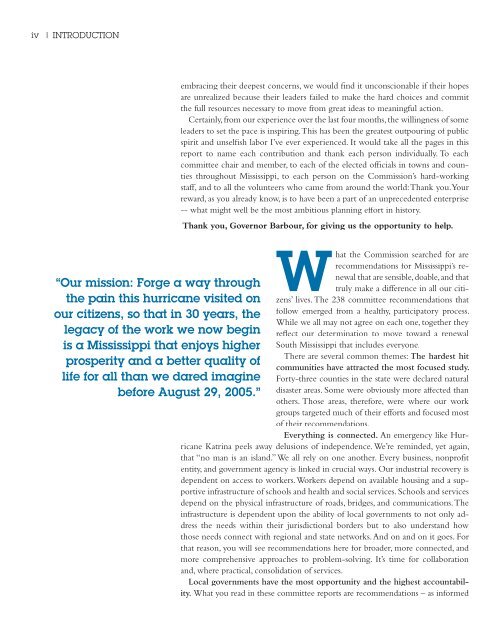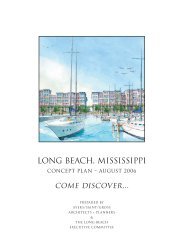Reports - Mississippi Renewal
Reports - Mississippi Renewal
Reports - Mississippi Renewal
- No tags were found...
Create successful ePaper yourself
Turn your PDF publications into a flip-book with our unique Google optimized e-Paper software.
iv | INTRODUCTIONembracing their deepest concerns, we would find it unconscionable if their hopesare unrealized because their leaders failed to make the hard choices and committhe full resources necessary to move from great ideas to meaningful action.Certainly, from our experience over the last four months, the willingness of someleaders to set the pace is inspiring. This has been the greatest outpouring of publicspirit and unselfish labor I’ve ever experienced. It would take all the pages in thisreport to name each contribution and thank each person individually. To eachcommittee chair and member, to each of the elected officials in towns and countiesthroughout <strong>Mississippi</strong>, to each person on the Commission’s hard-workingstaff, and to all the volunteers who came from around the world: Thank you. Yourreward, as you already know, is to have been a part of an unprecedented enterprise-- what might well be the most ambitious planning effort in history.Thank you, Governor Barbour, for giving us the opportunity to help.“Our mission: Forge a way throughthe pain this hurricane visited onour citizens, so that in 30 years, thelegacy of the work we now beginis a <strong>Mississippi</strong> that enjoys higherprosperity and a better quality oflife for all than we dared imaginebefore August 29, 2005.”What the Commission searched for arerecommendations for <strong>Mississippi</strong>’s renewalthat are sensible, doable, and thattruly make a difference in all our citizens’lives. The 238 committee recommendations thatfollow emerged from a healthy, participatory process.While we all may not agree on each one, together theyreflect our determination to move toward a renewalSouth <strong>Mississippi</strong> that includes everyone.There are several common themes: The hardest hitcommunities have attracted the most focused study.Forty-three counties in the state were declared naturaldisaster areas. Some were obviously more affected thanothers. Those areas, therefore, were where our workgroups targeted much of their efforts and focused mostof their recommendations.Everything is connected. An emergency like HurricaneKatrina peels away delusions of independence. We’re reminded, yet again,that “no man is an island.” We all rely on one another. Every business, nonprofitentity, and government agency is linked in crucial ways. Our industrial recovery isdependent on access to workers. Workers depend on available housing and a supportiveinfrastructure of schools and health and social services. Schools and servicesdepend on the physical infrastructure of roads, bridges, and communications. Theinfrastructure is dependent upon the ability of local governments to not only addressthe needs within their jurisdictional borders but to also understand howthose needs connect with regional and state networks. And on and on it goes. Forthat reason, you will see recommendations here for broader, more connected, andmore comprehensive approaches to problem-solving. It’s time for collaborationand, where practical, consolidation of services.Local governments have the most opportunity and the highest accountability.What you read in these committee reports are recommendations – as informed




